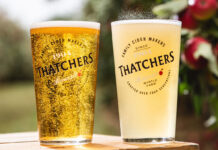Demand for hard seltzers and pre-mixed cocktails to remain high this summer

THE RTD (ready-to-drink) category has evolved considerably in recent years, with the more ‘traditional’ brands and products being joined by a wide range of pre-mixed cocktails and – more recently – hard seltzers.
And while the nature of the category has traditionally lent itself more to the off-trade than to bars, pubs and restaurants, drinks companies reckon it’s more than worthwhile for operators to consider ready-to-drink products for their venues this summer.
Lauren Priestley of Diageo said the category has grown in recent years “as consumers look to products that offer convenience and high quality”.
In fact, quoting Nielsen figures, Priestley said RTDs are currently outperforming the total off-trade beer, wines and spirits market.
As the category has developed, its appeal has broadened, according to Boë Gin director, Carlo Valente, who said the flavour profiles and packaging of contemporary ready-to-drink products has made them more appealing to a wider range of consumers. “The new style of RTDs are definitely more grown up in their packaging and style so while they do not exclude the younger legal drinking age they appeal to a more mature and broader demographic,” said Valente.
The hard seltzer corner of the market, in particular, has seen an explosion in new products in the past few years, as well as the appearance of brands from overseas – such as US market leader White Claw.
Tashinga Garwe, senior trade marketing manager of Mark Anthony Brands, the UK distributor of White Claw, said hard seltzers have proved popular because they offer ”a light, refreshing alcoholic alternative to beer, cider and cocktails, making for a sessionable collection of drinks in a variety of flavours”.
Figures provided by the company state that hard seltzers were worth a comparatively modest £15.6 million in the UK at the close of 2021, but were growing at a rate of 172%.
In terms of the number of products available, the market seems to be growing even faster than that.
Molson Coors, for example, has introduced two hard seltzer brands to the UK – Three Fold and Bodega Bay – with the former currently being promoted through a major marketing campaign.
Mark Bentley, on-trade category controller at Molson Coors, described Three Fold as “a new brand with mainstream appeal that taps into the growing hard seltzer opportunity in the UK”.
Hannah Fisher, co-founder of Scottish hard seltzer brand Lilo, said the expansion of the hard seltzer market is unlike anything the team has encountered before.
She said: “As a team, we have collectively worked across every drinks category over the past 20 years and the hard seltzer category is definitely the most unusual from the viewpoint that it’s become incredibly competitive in a short period of time with almost every drink company (big and small) launching a brand, but consumer awareness is still extremely low.”
Fisher reckoned the 18 to 30 age group currently has the highest awareness of hard seltzers, given that age group’s interest in lower-alcohol products.
“As such, high volume accounts that attract the younger consumers that are looking for a speedy serve are the most open to trial,” said Fisher.
“Cans still prove a challenge amongst lower volume, more premium accounts with a slightly older clientele.”
The raft of new products has almost certainly been due to predictions of massive growth in hard seltzer sales, based largely on the category’s performance in the US.
George Blurton of hard seltzer producer Long Shot Drinks said that, although sales in the UK “haven’t quite seen the meteoric overnight success seen in the US”, they are moving in the right direction.
“We’re at the beginning of the seltzer boom here in the UK, but with the market set to grow from £10.4m (in 2020) to over £75m by 2023, we expect hard seltzers to fully infiltrate the mainstream in the coming years, owing to their refreshing nature, and their ability to fit into a more health-conscious lifestyle,” he said.
Blurton predicted the lighter style of the products – which are essentially fruit-flavoured water with alcohol – is likely to make them particularly popular over the summer months.
So far, said Blurton, the products have proved most popular with fans of lighter drinks such as vodka and soda or gin and tonic.
And although he agreed that hard seltzers were proving popular with younger consumers, Blurton reckoned they are well suited to a broad demographic.
“The low-calorie nature of the drinks means they naturally resonate with a younger, more health-conscious consumer, but the beauty of the hard seltzer movement is that it can appeal to a wider spectrum of drinkers than just that,” he said.
“The drinks can fit into a variety of diets – being good options for those on gluten-free, vegan or keto-friendly diets, or simply for anyone looking to cut down on their sugar intake where possible.”
That was echoed by Ruth Jones, co-founder of Scottish hard seltzer brand, Twisted Sisters, who said the brand had been making headway with a “mixed customer base”.
“While hard seltzers can be seen as more of a female drink, we certainly haven’t seen that to be the case,” said Jones.
“Hard seltzers seem to be particularly popular with the mid-20 to 40 year market and people who are a bit more mindful of what they’re drinking.
“Our core venues tend to be small to mid-size city centre bars and craft beer venues.”
And Blurton predicted there could be a large untapped market in an unexpected place: the male beer or cider drinker.
“The typical lager and cider drinker is seeking out a simple, refreshing and trustworthy taste when weighing up his next choice at the bar – boxes that hard seltzers can tick equally well too,” said Blurton.
“When reminded that by opting for a pint of seltzer over their normal fruit cider, they could cut their calorie intake by half, the trade-off might make sense to try something new.
“The key, however, lies in making sure bar staff are trained and knowledgeable enough about the seltzer category.”
























